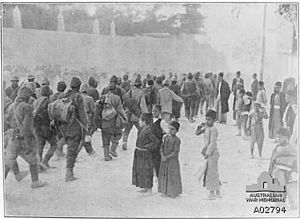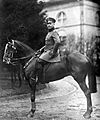Battle of Nablus (1918) facts for kids
Quick facts for kids Battle of Nablus |
|||||||
|---|---|---|---|---|---|---|---|
| Part of the Middle Eastern theatre of World War I | |||||||
 Ottoman prisoners march under escort through Nablus |
|||||||
|
|||||||
| Belligerents | |||||||
|
|||||||
| Commanders and leaders | |||||||
| Units involved | |||||||
| Egyptian Expeditionary Force XX Corps Chaytor's Force |
Yildirim Army Group Seventh Army Asia Corps (Eighth Army) Fourth Army |
||||||
The Battle of Nablus was a major fight during the First World War in the Middle East. It happened between September 19 and 25, 1918. This battle was part of a bigger plan called the Battle of Megiddo.
During the Battle of Nablus, soldiers from the British Empire (including troops from Britain, India, Australia, New Zealand, and South Africa) and Arab fighters worked together. They fought against the armies of the Ottoman Empire and German Empire. The fighting took place in the Judean Hills and the Jordan Valley, near a town called Nablus.
The goal for the British and their allies was to push back the Ottoman armies and capture important areas. They succeeded, taking many prisoners and a lot of land. This victory was a big step towards the end of the war in the Middle East.
Why the Battle Happened
The Situation Before the Battle
After losing a battle at Beersheba and other areas in 1917, the Ottoman army in Palestine changed some of its leaders. A German general, Otto Liman von Sanders, took charge of the main Ottoman army group.
At the same time, the British army also had to change its plans. Many British soldiers were sent to France to fight in another part of the war. To replace them, the British brought in many soldiers from the British Indian Army. These new troops were trained and ready to fight.
General Edmund Allenby, who led the British forces, wanted to attack in September 1918. He aimed to capture important towns like Tulkarm and Nablus, which were headquarters for the Ottoman armies. He also wanted to control the roads leading to the Jordan River.
How the British Army Changed
To make up for soldiers sent to France, the British army in Palestine got many new troops from India.
- Some British army groups, called divisions, were changed. They now had one British battalion (a group of soldiers) and three Indian battalions.
- Two large Indian army divisions, the 7th and 3rd, arrived from another fighting area called Mesopotamia.
- Many of the new Indian battalions were formed by taking experienced soldiers from other units. This helped make sure the new groups were strong.
- However, some of the new Indian battalions had many new recruits. Also, some British officers couldn't speak the local languages, which made communication harder.
The Front Line
In September 1918, the battle line was very long.
- It started near the Mediterranean Sea, then went southeast across a flat area called the Plain of Sharon.
- Then it went eastward over the Judean Hills, where the land was much higher.
- From the hills, the line dropped down into the Jordan Valley, which is below sea level.
- Finally, it ended in the hills of Gilead.
Railways: Important Supply Lines
Railways were very important for moving supplies and soldiers.
- The main Ottoman railway came from Istanbul and split into two lines at Deraa.
- One line went south to supply the Ottoman Fourth Army.
- The other line went west to supply the Seventh and Eighth Armies in the Judean Hills. This line crossed the Jordan River and went to towns like Beisan and Afulah.
- From Afulah, the railway split again, with one line going to Haifa and the main line going south to Jenin.
- From Jenin, the railway went to Messudieh Junction, where it split again. One line went to Tulkarm (Eighth Army headquarters) and the other to Nablus (Seventh Army headquarters).
Planning the Attack
General Allenby's plan for the Battle of Megiddo, which included the Battle of Nablus, focused on surprise and speed.
- The British planned a very strong artillery attack to break through the Ottoman lines.
- They also wanted to control the sky. British and Australian planes bombed Ottoman headquarters and communication lines to stop them from talking to each other.
- The goal was to quickly capture the Esdraelon Plain, which was about 50 miles away.
British Army Groups and Their Roles
- XX Corps: This group, led by Lieutenant General Phillip Chetwode, was positioned in the Judean Hills. Their job was to capture Nablus by attacking from both sides of the main road.
- Chaytor's Force: Led by Major General Edward Chaytor, this group was in the Jordan Valley. Their main job was to protect the eastern side of the British front line. They also had to capture the Jisr ed Damieh bridge if the Ottoman army started to retreat.
- Air Support: The Royal Air Force (RAF) and Australian Flying Corps (AFC) played a huge role. They flew planes for scouting (reconnaissance), bombing, and attacking enemy soldiers with machine guns. They especially targeted Ottoman headquarters and supply lines.
- Medical Support: The British had many hospitals and beds ready in Palestine and Egypt to care for wounded soldiers.
Ottoman Army Groups and Their Positions
The Ottoman army, led by General Liman von Sanders, had about 40,000 soldiers spread along a 90-kilometer (about 56 miles) front line. They had many machine guns and were in strong defensive positions in the Judean Hills.
- Eighth Army: This army, with about 10,000 soldiers, was on the western side of the front line, near the coast. Its headquarters was at Tulkarm.
- Seventh Army: This army, with about 7,000 soldiers, was in the Judean Hills, with its headquarters at Nablus. Mustafa Kemal Pasha, who later became a very important leader in Turkey, was one of its commanders.
- Fourth Army: This army, with about 6,000 infantry and 2,000 cavalry, was on the eastern side of the front line, in the Jordan Valley. Its headquarters was at Amman.
Some reports said the Ottoman armies were short on soldiers and supplies, and many soldiers were leaving the army.
The Battle Begins
First Attacks (September 18)
On September 18, the British 53rd Division tried to capture an important area called the Samieh basin. This area overlooked Ottoman roads and was needed to build a new British road.
- British soldiers attacked at night, moving through difficult rocky land.
- They faced strong Ottoman defenses and machine gun fire.
- Despite heavy losses, they managed to capture some key positions.
- At the same time, a big artillery attack started on the western side of the front line, beginning the Battle of Sharon.
Converging on Nablus (September 19)
Instead of a direct attack, the British XX Corps planned to surround Nablus.
- The 10th Division would attack from the left to capture Nablus.
- The 53rd Division would move east of Nablus to cut off escape routes to the Jordan River.
- The XX Corps' artillery bombardment started at 7:30 PM.
- The 10th Division attacked strong Ottoman positions and captured the village of Furkhah. They continued to advance towards Selfit.
- In the Jordan Valley, Chaytor's Force also faced tough Ottoman resistance.
Pushing Forward (September 20)
- The 10th Division advanced about 7 miles before dawn, but then met strong Ottoman resistance. They needed artillery support to continue.
- The 53rd Division also found it hard to advance due to the difficult terrain and strong Ottoman rearguards (small groups of soldiers left behind to slow down the enemy).
- In the middle, a smaller British force, Watson's Force, advanced north on the road to Nablus. They found the road heavily mined, but engineers cleared the mines.
- By the end of the day, the British had captured many prisoners. The Ottoman Eighth Army was mostly defeated, and the Seventh Army was retreating.
- British planes bombed the retreating Ottoman soldiers and their vehicles, causing huge damage and blocking roads.
Capture of Nablus (September 21)
General Chetwode ordered the XX Corps to continue their attacks. The 10th Division was to capture Nablus, and the 53rd Division was to cut off the escape routes to the Jordan Valley.
- The 10th Division resumed its advance at 11:30 PM on September 20.
- A strong Ottoman rearguard near Rujib, south of Nablus, delayed the British for about an hour.
- The 5th Light Horse Brigade (Australian cavalry) was ordered to help capture Nablus. They rode quickly along the road, despite wreckage from earlier bombings.
- The 5th Light Horse Brigade, along with armored cars, attacked the last Ottoman resistance outside Nablus and captured the town. They took between 800 and 900 prisoners and two cannons.
- The 10th Division also reached Nablus around noon, meeting the Australian cavalry.
- General Allenby himself drove into Nablus that evening, ahead of his main troops. He saw thousands of Ottoman soldiers surrendering.
Ottoman Retreat and Air Attacks
- By the afternoon of September 21, organized Ottoman resistance in the Judean Hills had stopped. Most of the Eighth Army had surrendered, and the Seventh Army was retreating east towards the Jordan River.
- Liman von Sanders, the Ottoman commander, fled from Nazareth to Damascus.
- A large column of Ottoman soldiers retreating down the Wadi el Fara road was heavily bombed by British and Australian planes. The planes destroyed many cannons, trucks, and other vehicles, blocking the road. This caused huge chaos and losses for the Ottoman army.
Chaytor's Force Continues the Fight (September 21–25)
- On September 21, Chaytor's Force advanced on the western side of the Jordan River.
- Early on September 22, they captured the bridge at Jisr ed Damieh and other river crossings, cutting off a main Ottoman escape route.
- The Ottoman Fourth Army began to retreat. Chaytor's Force pursued them, capturing Es Salt on September 23 and Amman on September 25.
- Another large group of Ottoman soldiers was captured near Ziza on September 29.
Air Support Throughout the Battle
- The Royal Air Force provided vital scouting reports and attacked enemy lines with bombs and machine guns. These attacks caused "destruction, death, and terror" and paralyzed the Ottoman communication centers.
- Australian planes bombed important targets like the telephone exchange at Afulah even before the main battle began.
- Planes constantly attacked retreating Ottoman columns, especially on the roads leading to the Jordan River. These attacks were very effective in stopping the Ottoman retreat.
Aftermath
- After the battle, British troops continued to clear the hills between Nablus and Beisan, capturing another 1,500 prisoners.
- In total, the XX Corps captured 6,851 prisoners, 140 cannons, and many machine guns. They had 1,505 casualties (killed or wounded).
- Chaytor's Force captured over 10,000 prisoners, 57 cannons, and 147 machine guns, with 27 killed and 105 wounded.
- By the end of September, the remaining Ottoman soldiers, about 6,000 men, were retreating towards Damascus.
The Battle of Nablus, as part of the larger Battle of Megiddo, was a huge victory for the British and their allies. It severely weakened the Ottoman army in the Middle East and led to the capture of Damascus on October 1. This success helped bring the fighting in the Sinai and Palestine campaign to an end.
Images for kids











